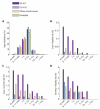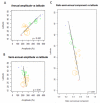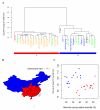Hand, foot, and mouth disease in China, 2008-12: an epidemiological study
- PMID: 24485991
- PMCID: PMC4035015
- DOI: 10.1016/S1473-3099(13)70342-6
Hand, foot, and mouth disease in China, 2008-12: an epidemiological study
Abstract
Background: Hand, foot, and mouth disease is a common childhood illness caused by enteroviruses. Increasingly, the disease has a substantial burden throughout east and southeast Asia. To better inform vaccine and other interventions, we characterised the epidemiology of hand, foot, and mouth disease in China on the basis of enhanced surveillance.
Methods: We extracted epidemiological, clinical, and laboratory data from cases of hand, foot, and mouth disease reported to the Chinese Center for Disease Control and Prevention between Jan 1, 2008, and Dec 31, 2012. We then compiled climatic, geographical, and demographic information. All analyses were stratified by age, disease severity, laboratory confirmation status, and enterovirus serotype.
Findings: The surveillance registry included 7,200,092 probable cases of hand, foot, and mouth disease (annual incidence, 1·2 per 1000 person-years from 2010-12), of which 267,942 (3·7%) were laboratory confirmed and 2457 (0·03%) were fatal. Incidence and mortality were highest in children aged 12-23 months (38·2 cases per 1000 person-years and 1·5 deaths per 100,000 person-years in 2012). Median duration from onset to diagnosis was 1·5 days (IQR 0·5-2·5) and median duration from onset to death was 3·5 days (2·5-4·5). The absolute number of patients with cardiopulmonary or neurological complications was 82,486 (case-severity rate 1·1%), and 2457 of 82486 patients with severe disease died (fatality rate 3·0%); 1617 of 1737 laboratory confirmed deaths (93%) were associated with enterovirus 71. Every year in June, hand, foot, and mouth disease peaked in north China, whereas southern China had semiannual outbreaks in May and September-October. Geographical differences in seasonal patterns were weakly associated with climate and demographic factors (variance explained 8-23% and 3-19%, respectively).
Interpretation: This is the largest population-based study up to now of the epidemiology of hand, foot, and mouth disease. Future mitigation policies should take into account the heterogeneities of disease burden identified. Additional epidemiological and serological studies are warranted to elucidate the dynamics and immunity patterns of local hand, foot, and mouth disease and to optimise interventions.
Funding: China-US Collaborative Program on Emerging and Re-emerging Infectious Diseases, WHO, The Li Ka Shing Oxford Global Health Programme and Wellcome Trust, Harvard Center for Communicable Disease Dynamics, and Health and Medical Research Fund, Government of Hong Kong Special Administrative Region.
Copyright © 2014 Elsevier Ltd. All rights reserved.
Figures







Comment in
-
Surveillance of hand, foot, and mouth disease for a vaccine.Lancet Infect Dis. 2014 Apr;14(4):262-3. doi: 10.1016/S1473-3099(13)70330-X. Epub 2014 Jan 31. Lancet Infect Dis. 2014. PMID: 24485992 No abstract available.
-
Hand, foot, and mouth disease in mainland China.Lancet Infect Dis. 2014 Nov;14(11):1041. doi: 10.1016/S1473-3099(14)70973-9. Epub 2014 Oct 19. Lancet Infect Dis. 2014. PMID: 25444400 No abstract available.
-
Hand, foot, and mouth disease in mainland China.Lancet Infect Dis. 2014 Nov;14(11):1041. doi: 10.1016/S1473-3099(14)70972-7. Epub 2014 Oct 19. Lancet Infect Dis. 2014. PMID: 25444401 No abstract available.
-
Hand, foot, and mouth disease in mainland China--authors' reply.Lancet Infect Dis. 2014 Nov;14(11):1042. doi: 10.1016/S1473-3099(14)70975-2. Epub 2014 Oct 19. Lancet Infect Dis. 2014. PMID: 25444402 No abstract available.
-
Hand, foot, and mouth disease in mainland China.Lancet Infect Dis. 2014 Nov;14(11):1042. doi: 10.1016/S1473-3099(14)70974-0. Epub 2014 Oct 19. Lancet Infect Dis. 2014. PMID: 25444403 No abstract available.
References
-
- Melnick JK. Enteroviruses: polioviruses, coxsackieviruses, echoviruses, and newer enteroviruses. In: Fields BN, Knipe DM, Howley PM, Chanlock RM, Melnick JL, Monath TP, et al., editors. Field’s virology. 3rd ed Lippincott-Raven; Philadelphia: 1996. pp. 655–712.
-
- Ooi MH, Wong SC, Lewthwaite P, Cardosa MJ, Solomon T. Clinical features, diagnosis, and management of enterovirus 71. Lancet Neurol. 2010;9:1097–105. - PubMed
-
- Schmidt NJ, Lennette EH, Ho HH. An apparently new enterovirus isolated from patients with disease of the central nervous system. J Infect Dis. 1974;129:304–9. - PubMed
-
- Chan LG, Parashar UD, Lye MS, Ong FG, Zaki SR, Alexander JP, et al. Deaths of children during an outbreak of hand, foot, and mouth disease in sarawak, malaysia: clinical and pathological characteristics of the disease. For the Outbreak Study Group. Clin Infect Dis. 2000;31:678–83. - PubMed
-
- Ho M, Chen ER, Hsu KH, Twu SJ, Chen KT, Tsai SF, et al. An epidemic of enterovirus 71 infection in Taiwan. Taiwan Enterovirus Epidemic Working Group. N Engl J Med. 1999;341:929–35. - PubMed
Publication types
MeSH terms
Grants and funding
LinkOut - more resources
Full Text Sources
Other Literature Sources
Research Materials
